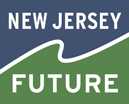New Jersey Future Blog
Sustainable Water Management: Program Rundown of Municipal Options
December 18th, 2023 by Michael Atkins
The following feature was originally published in the December 2023 edition of NJ Municipalities Magazine, which has been relied upon by local government leaders, department heads and administrators for over 100 years. NJ Municipalities is read by over 6,000 readers each month. You can read an online version, or view the pdf of the print edition.
The future of New Jersey’s water relies on commitment to equitable decision-making to solve legacy water infrastructure issues like lead service line replacement, combined sewer overflows, coastal and riverine flooding, and upgrading water infrastructure. By working together to address the growing needs of our water systems, we can properly mitigate the stress they will face with growing and more frequent storms fueled by climate change, and ensure that natural and tap waters are free from contaminants to support healthy and resilient communities across the state. Learn more about the programs and resources available to assist municipal leaders in addressing these issues within their communities.
MS4 Primer
Over 90% of New Jersey’s waterways are considered impaired, and over 60% can be attributed to pollutants from stormwater runoff. In January 2023, the New Jersey Department of Environmental Protection (NJ-DEP) issued an updated Tier A Municipal Separate Storm Sewer System (MS4) Permit to address these water quality impairments and flooding issues.
The updated permit reflects a shift toward water-shed-level planning with the inclusion of a mandatory Watershed Improvement Plan requirement. For a highly developed state with large quantities of impervious cover, it is more important than ever to plan ahead to improve our water and protect all New Jerseyans from flooding events worsened by climate change.
New Jersey Future and One Water Consulting, LLC created an MS4 Primer to help municipalities understand the recent changes to the MS4 Permit and improve their municipal stormwater programs. The MS4 Permit and this primer provide a framework for water quality improvements and a regional approach to stormwater management in New Jersey. Contact our Mainstreaming Green Infrastructure Program Manager Lindsey Sigmund (lsigmund njfuture
njfuture org) to get your copy of the MS4 Primer.
org) to get your copy of the MS4 Primer.
Looking for funding to get started on permit compliance? Apply for NJDEP’s Tier A MS4 Stormwater Assistance Grants. There is funding allocated for every municipality in New Jersey. Rolling deadline is December 31.
Funding Navigator
Water utilities around the state need funds, either low interest loans or grants for capital improvement projects to repair or enhance their systems. To help the most underserved water systems identify and navigate agency application processes to secure government funding, New Jersey Future has created its new and innovative Funding Navigator program.
Launched in April of this year, the Funding Navigator program specializes in offering meaningful community engagement and access to free professional technical assistance services to small-to-medium sized under-resourced public water utilities and municipalities. This is the first nonprofit statewide program committed to helping localities access funding for drinking water, wastewater, and stormwater needs. By coordinating with other providers such as New Jersey Department of Environmental Protection, Environmental Policy Innovation Center (EPIC), Syracuse University, and Moonshot Missions, NJF leverages a wide range of resources to help tailor unique funding application consultation to unique water infrastructure problems.
The federal Bipartisan Infrastructure Law allocates approximately $900 million over 5 years for water infrastructure improvements in New Jersey. The Governor and the Legislature also allocated nearly $300 million in American Rescue Plan Act funding for water infrastructure. New Jersey Future’s Funding Navigator program is designed to steer these funds, along with other state funding, to those water systems and municipalities that need it most. These funds are time limited, so it is crucial for municipalities to begin applying for funding. The Funding Navigator helps eligible municipalities and water systems by aiding with upfront application costs for engineering design and legal fees, community and stakeholder outreach, gap analysis report/presentation of water utility systems,
and funding application review and consultation.
Pursuing financial infrastructure support does not have to be a complicated and arduous journey. Navigating these streams of funding with the New Jersey Future Funding Navigator staff and partners can make for a smoother process. To learn more about our Funding Navigator program and step by step process working with municipalities and water utilities, please visit us at www.njfuture.org/new-jersey-funding-navigator/ or contact our Program Manager, Lee M. Clark (lclark njfuture
njfuture org) .
org) .
Jersey WaterCheck
This data dashboard connects water consumers, utilities, and decision-makers with easy-to-understand information on drinking water and wastewater systems in New Jersey. This tool to tracks progress of local water/sewer utility and showcases success stories in infrastructure improvements.
The dashboard was created to serve Jersey Water Works, a statewide collaborative working on New Jersey’s water infrastructure challenges. Metrics on both the Shared Goals, and Benchmark Hub pages are categorized according to Jersey Water Works’ goals and subgoals, such as Effective and Financially Sustainable Systems, Wise Management and Spending, and Transparent Water Systems. Each metric on Jersey WaterCheck has a description that explains the information being shown, and things to keep in mind when reading it. From the home page of Jersey WaterCheck, you can learn about an individual water or wastewater system using the System Finder.
On a particular water or wastewater system page, metrics are displayed on cards that are organized based on “Communication Categories,” which were created specifically for this dashboard. Jersey WaterCheck provides granular utility level and state level actionable information that can help generate community support for decision making on water infrastructure needs. Visit www.njwatercheck.org.
SRF Equity Report
New Jersey Future recently published a report examining how funding reaches water systems of all sizes throughout the state, Improving a Program that Works: Prioritizing New Jersey Water Bank Projects in Disadvantaged Communities. The New Jersey Water Bank (NJWB), which finances water infrastructure projects, is a successful program that has provided over $9 billion in low-cost financing for water and wastewater projects. New Jersey Future partnered with the national Environmental Policy Innovation Center in producing the report, which analyzes NJWB awards and provides 10 recommendations to increase equity and effectiveness of the NJWB. Visit njfuture.org/research-reports/srfequity
Lead-Free New Jersey
Every water system in New Jersey must identify and replace all lead service lines by 2031. Jersey Water Works and Lead-Free NJ have resources for elected and municipal leaders to achieve this goal, thanks in part to the collaborative efforts of our diverse members.
Two resources of note include the Primer for Mayors, produced by the Lead in Drinking Water Task Force, and our Community Hubs, operated by Lead-Free NJ.
The Lead in Drinking Water Task Force, which provides policy recommendations to Lead-Free NJ and assists Jersey Water Works in supporting a community of state water leaders, advances statewide policy while empowering municipal and local leaders with the necessary information to ensure equitable, cost-effective, and efficient lead service line replacement through resources like the 2023 Primer for Mayors – Let’s Get the Lead Out of Our Drinking Water: Lead Service Line Efficiency Measures. This most recent edition includes 10 recommended efficiency measures to assist municipalities and water agencies to better inform and collaborate with their communities.
For more information, visit www.leadfreenj.org/community-work.
The Future of Housing in New Jersey
November 30th, 2023 by New Jersey Future staff
The following feature was originally published in the November 2023 edition of NJ Municipalities Magazine, which has been relied upon by local government leaders, department heads and administrators for over 100 years. NJ Municipalities is read by over 6,000 readers each month. You can read an online version, or view the pdf of the print edition.
By Chris Sturm and Michael Atkins
Housing shapes communities while communities shape the quality of life and access to opportunities for each of us. Local officials are on the front lines of housing development, shaping what kind of housing gets built, where it can be constructed, and the local roads and sidewalks residents use to get from their homes to everywhere else. Municipalities have the authority to adopt land use plans, set zoning codes, and create redevelopment areas and parking maximums that facilitate high quality places. Municipalities and counties have the transportation teams to design, pave, and maintain the streets and sidewalks that create the character of a community and determine if it is welcoming and safe for all users. If “home is where the heart is”, then housing is at the heart of a strong and inclusive New Jersey.
But the external challenges facing local leaders have become more complicated and more intense. The COVID-19 pandemic and climate change in particular have exacerbated the pressing issues of escalating housing costs, pedestrian safety, displacement of lower-income people, empty office space, and flooding, to name a few. Recent economic turmoil due to the pandemic only amplified these pressures—first demand and inflation drove up housing prices, and now high interest rates have made mortgage financing increasingly difficult.
As a nonprofit organization focused on land use and smart growth, New Jersey Future works to help communities emerge strong from crises. And together with many partners—including local and state government, developers, community activists, and environmentalists—we see housing as not only the center of much debate but as an important lever to advance strong, healthy, resilient communities for everyone.
Center-based housing development
Towns and cities that encourage a range of housing types in walkable neighborhoods and centers aren’t just revitalizing town and city centers for aesthetics. Successful downtowns and centers are converting abandoned strip malls, vacant shops, and empty office space to new housing, which provide municipalities with more reliable, steady, tax revenues, often without adding the costs of new students to their school district. The result is stronger tax ratables and dynamic live-work-shop places where residents enjoy local restaurants, parks and theaters. Towns should not overlook the benefits of providing mixed-use centers to their local residents, and enabling their residents to host friends and family at their favorite places to promote even further commercial activity.
Center-based housing development supports long-time residents as they undergo changes in life, but seek to remain close to their personal networks that provide them fulfilling opportunities to live full and meaningful lives. Consider empty nesters looking to downsize from their single-family home to age in place, and newly separated parents who want to continue to live in the same school district that their children attend. While occupancy rates for office and retail space have been weakened by post-pandemic hybrid work schedules and online shopping, the demand for center-based housing is robust, and growing as new generations, primarily Millennials and Gen Z, seek to live close to family, but with a modicum of urbanity to facilitate their hobbies and interests. Towns and cities that plan and zone for center-based housing create options for their community members undergoing life transitions, without forcing them to relocate.
Walkable places with a mix of housing and services simplify the way residents get between home, pick up their children from school, and make it to their next doctor’s appointment. Smartly designed, compact town and city centers can reduce commute times and allow people to accomplish multiple tasks within one trip, ideally returning time back to people by freeing them from commuting long distances in their private vehicles and sitting in traffic congestion.
Attainable housing
Rising costs of housing in New Jersey are a significant driver of the growing affordability crisis in the state. A 2021 Rutgers-Eagleton poll “found that 90% of New Jerseyans are worried about the cost of housing in the state, with 55% considering it a “very serious” problem.” It’s in New Jersey’s best interest economically, socially, and environmentally for our local leaders to provide stable and lower-cost housing options in their communities, so the state as a whole is more affordable. New Jersey’s high cost of housing has long had an impact on the state’s “brain drain”, the migration of highly educated individuals out of the state, due to the lack of housing access.
Developing additional housing also eases pressures on lower-income households. In the absence of new development or quality redevelopment, affluent households will outcompete lower-income households, fueling gentrification and triggering displacement of long-time residents. Housing affordability is not just about out-migration or displacement though. It raises basic quality-of-life questions like: What could households do with an additional $100 a week? What would commuters do with an additional two or three hours back in their lives?
Too many hard-working residents are unable to rent, let alone buy, in the communities in which they work. Teachers, healthcare professionals, and service workers of every variety, are commuting longer, often in their private automobile, to their places of work. “Across the state, municipalities that facilitate solutions to promote sustainable housing opportunities for all workers will see a ripple of positive effects for their communities,” observed Montclair Mayor Sean Spiller, who also serves as president of New Jersey Educators Association. “Making sure educators, and educational support professionals, and their families are able to live in the communities they serve if their circumstances allow, is a win-win for educators, students, and communities as a whole,” Spiller continued. “Aside from policies that fairly compensate hard working, vital public servants, like educators, New Jersey cities and towns should think holistically about the benefits of promoting diversity and sustainability within their communities, and as we’ve done in Montclair, take legislative action to achieve and preserve that diversity.”
Climate change and housing
The manner in which we build new and improve existing housing must assist in our broader climate change mitigation and adaptation efforts. New developments must be sited out of flood zones to foster resilience, safeguard public health and minimize property damage. They can be designed to reverse our mismanagement of stormwater. Sprawling developments, big box stores, and highly-developed downtowns have laid vast impermeable surfaces across our state. Rainwater runs off of these surfaces, pollutes our water supplies, and flooding worsens. Today, new development and conscientious redevelopment is beginning to rectify this issue by installing green infrastructure facilities like street trees, bioswales, and rain gardens. Municipalities can not only comply with new state regulations for stormwater management, they should embrace and encourage them as vital tools to address a growing risk.
Finally, compact densities can reduce car dependency, shorten trips, cut emissions, and improve air quality. By building a network of places well-linked by public transportation, we can ensure that New Jersey has its best foot forward and is ready to face the challenges of climate change with minimal loss of lives or property values.
The future of housing in New Jersey
Since its formation in 1987, New Jersey Future has steadfastly advocated for center-based development and smart redevelopment projects in accordance with our statewide goals of balancing development and preservation and spurring equitable economic growth. While we have had an eye to statewide progress, it is local municipal leaders and planners who have the tools and powers to encourage development and redevelopment that can deliver more housing that is affordable, inclusionary, climate resilient and located in walkable, people-oriented centers that increase commercial activity and improve public health.
But local community planning and zoning is tricky and complicated. Even as we celebrate local success stories (see this year’s Smart Growth Award winners in the sidebar), we know municipal leaders often struggle to redevelop and add housing supply to our already dense and well-connected state. Many of our partners in government, nonprofit, and the private sector are likewise interested in identifying and constructing solutions out of the current crunch.
Over the coming months, New Jersey Future will be convening partners and stakeholders to envision future housing development in our state that is equitable, affordable, resilient, and diverse. Through a collaborative process we seek to identify practical, actionable steps to get there including everything from understanding and elevating municipal needs, to state planning and policy, to partnering with low and moderate-income residents. We encourage readers to stay tuned as New Jersey Future and its partners work together on a set of solutions and publicize our findings in Spring 2024.
To inform that conversation, New Jersey Future is circulating a simple survey to collect the perspectives of municipal leaders, community members, planners, architects, and developers. We invite you to take 10 minutes or less and share your thoughts on the pressures, successes, and challenges you and your town are facing as we confront this together. Survey available online.
The NJ State Development and Redevelopment Plan is Being Updated – Where and How Should New Jersey Grow? Add Your Voice!
October 12th, 2023 by Chris Sturm
The NJ State Planning Commission is hosting a series of eight webinars in October to gather input on how to update the New Jersey State Development and Redevelopment Plan. Last adopted in 2001, the State Plan provides a comprehensive framework intended to guide future development, redevelopment, conservation, preservation, and restoration efforts in the state of New Jersey.
Each webinar focuses on one to two of the State Plan’s existing high-level goals and strategies or one of the two proposed new goals for Climate Change/Resilience and Equity/Environmental Justice. The webinars allow for high-level input through polls and a chat function. Interested parties may also submit written comments at this email (stateplan comments
comments sos
sos nj
nj gov) .
gov) .

Launching the Next State Plan session at the 2023 NJ Planning and Redevelopment Conference. State Planning Commission members in attendance included Tom Wright, Edward McKenna, Elizabeth Terenik, Stephen Santola, Bruce Harris, and Danielle Esser. Photo by Frank H. Conlon
Launching the Next State Plan was a session held at the 2023 Planning and Redevelopment conference and explored how to best update the State Plan to better reflect the present conditions and future outlook of New Jersey.
To learn more about the State Plan update, to register for a session, or view recordings of past sessions, visit www.publicinput.com/njstateplan. We will share information on additional opportunities to participate in the State Plan update process when available.
In the meantime, the 2023 Planning and Redevelopment Conference workshop, Launching the Next State Plan, explored how to best update the State Plan to better reflect the present conditions and future outlook of New Jersey.
Open Space, Historic and Cultural Preservation Strategies in an Updated State Plan
Date: Tuesday, October 17, 2023
Time: 9 a.m. – 11 a.m. (Eastern Time)
In this two-hour webinar, participants will hear a panel discussion on the State’s desire to enhance, preserve and use historic, cultural, scenic, open space and recreational assets by collaborative planning, design, investment, and management techniques. Our expert panel will provide feedback on updating the current language in Goal 7:
- Goal #7: Preserve and Enhance Areas with Historic, Cultural, Scenic, Open Space and Recreational Value
Panelist:
Julie Hain, Executive Director – South Jersey Cultural Alliance
Captain Bill Sheehan, Riverkeeper – Hackensack Riverkeeper
Vincent Mann, Chiefmann – Ramapough Land & Cultural Foundation
(Additional Palnelist to be announced)
Establishing Goals for Social Justice in an Updated State Plan
Date: Thursday, October 19, 2023
Time: 10 a.m. – 12 p.m. (Eastern Time)
In this two-hour webinar, participants will hear a panel discussion for establishing new goals and strategies for social justice in the updated NJ State Plan and the topic’s influence on all other Goals in the State Plan. Our expert panel will provide feedback on establishing language in new Goal 9:
- Goal #9: Prevent the Concentration of Adverse Environmental Impacts in Overburdened Communities
Panelist:
Deidre Belinfanti – Garden State Equality
Dr. John E. Harmon, Sr. IOM – African American Chamber of Commerce of NJ
(Additional Palnelist to be announced)
Establishing Goals for Climate Change & Resilience in an Updated State Plan
Date: Friday, October 20, 2023
Time: 9 a.m. – 11 a.m. (Eastern Time)
In this two-hour webinar, participants will hear a panel discussion for establishing new goals and strategies for climate change and resilience in the updated NJ State Plan and the topic’s influence on all other Goals in the State Plan. Our expert panel will provide feedback on establishing language in new Goal 8:
- Goal #8: Address the Negative Impacts of Global Climate Change
Panelist:
Paul Drake, Regional Public Affairs – PSE&G
Kerry Kirk-Pflugh, Executive Director – NJ Conference of Mayors
(Additional Palnelist to be announced)
Economic Development and Workforce Strategies in an Updated State Plan
Date: Monday, October 23, 2023
Time: 10 a.m. – 12 p.m. (Eastern Time)
In this two-hour webinar, participants will hear a panel discussion on the economic development and workforce strategies in the current NJ State Plan and their influence on revitalizing the State’s cities and towns. Our expert panel will provide feedback on updating the current language in Goals 1 and 3:
- Goal #1: Revitalize the State’s Cities and Towns
- Goal #3: Promote Beneficial Economic Growth, Development and Renewal for All Residents of New Jersey
Panelist: (To be announced)
Sound & Integrated Planning in an Updated State Plan
Date: Tuesday, October 24, 2023
Time: 2 p.m. – 4 p.m. (Eastern Time)
In this two-hour webinar, participants will hear a panel discussion on the Plan Endorsement process, planning based on capacity analysis and integrating planning with investment decisions at all levels of government and in the private sector. Our expert panel will provide feedback on updating the current State Plan language in Goal 10:
- Goal #10: Ensure Sound and Integrated Planning and Implementation Statewide
Panelist: (To be announced)
Green Infrastructure in the Garden State: Stormwater Research in the Delaware River Watershed
September 20th, 2023 by Brooke Schwartzman
In 2020, the New Jersey Department of Environmental Protection (NJDEP) updated the Stormwater Management Rules, which now require that municipalities incorporate green infrastructure into major development projects. In many areas of the state, this relatively new policy change has meant a significant departure from the way that stormwater management was approached previously. New Jersey Future (NJF) sought to explore the impact of the rule change on green infrastructure implementation in New Jersey’s Delaware River Watershed region.
Stormwater is water that accumulates on land either through rain or snow, but instead of soaking into the ground as it would in nature, it accumulates into stormwater runoff. Poorly managed stormwater can result in a host of negative consequences like flash flooding and water quality issues caused by nonpoint source pollution. Green infrastructure (GI) is a solution to addressing stormwater runoff. This umbrella term includes any structure or installation that manages stormwater by protecting, restoring, or mimicking the natural water cycle. Consequently, GI decreases impervious cover and the stress on outdated stormwater infrastructure and effectively filters said water before inundating it back into the ground.
New Jersey has several regulatory structures in place to control stormwater as part of the National Pollutant Discharge Elimination System (NPDES). One such structure is N.J.A.C. 7:8, commonly known as the Stormwater Management Rules, which requires municipalities to hold a Municipal Separate Storm Sewer System (MS4) permit. Municipalities receive the MS4 permit after developing a stormwater program and meeting Statewide Basic Requirements (SBR) which set minimum standards for controlling stormwater pollution and inundation. One of the SBRs is for municipalities to develop a Stormwater Control Ordinance (SCO) that codifies compliance with N.J.A.C. 7:8. The SCO is then applied to all major development and redevelopment projects within the municipality. When NJDEP makes an amendment to their Stormwater Management Rules, municipalities are required to reflect that update in their SCOs within one year of the effective changes. Stormwater data for all NJ municipalities is available online through Jersey WaterCheck.
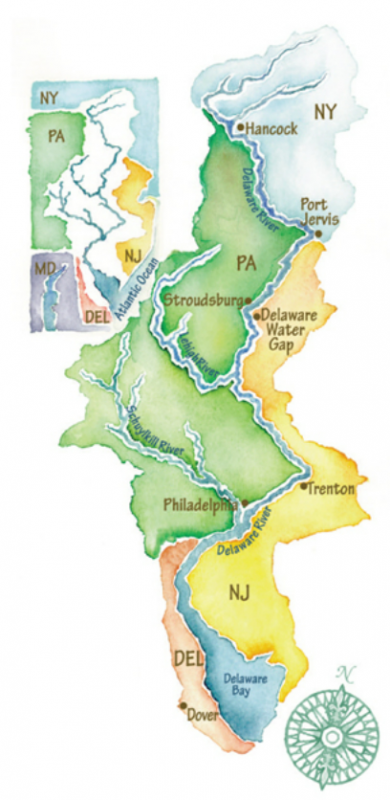
The Delaware River Basin. Source: Delaware River Basin Commission
In spite of its many benefits, green infrastructure is still underutilized in New Jersey. NJDEP sought to address this by making changes to the Stormwater Management Rules in 2020 that officially took effect in March 2021. The biggest difference between the Stormwater Management Rules then and now is how SCOs are expected to regulate GI. Prior, the minimum amount of GI that SCOs had to have demanded was “the maximum extent practicable”, leaving loopholes for the installation of green infrastructure. Now, SCOs require that GI be used for every major development project. Additionally, as part of New Jersey Protecting Against Climate Threats (NJ PACT), updates to the stormwater management rules went into effect on July 17, 2023, due to the Inland Flood Protection Rules. Further updates are expected as part of Resilient Environments and Landscapes (REAL). NJDEP released a model stormwater ordinance to guide municipalities as they amend their SCOs. This ordinance uses minimum standards but municipalities are free to make those standards stricter. NJF released their own enhanced model stormwater ordinance in 2021 to demonstrate ways in which municipalities could go above and beyond minimum requirements, such as including the definition of minor development and reducing the threshold for major development in their SCO. Municipalities that implement an enhanced model ordinance are eligible for Sustainable Jersey points.
New Jersey Future wanted to understand how the updated SCOs are impacting the implementation of green infrastructure, specifically in the Delaware River Watershed. The Delaware River Watershed is an interesting case study because it intersects with over 200 municipalities in New Jersey and several other states. 30 municipalities were selected for outreach. Communities were more likely to be targeted if they had populations especially vulnerable to flooding impacts, had certain kinds of infrastructure present suitable for complete and green streets, or were located in certain ecological regions. 27 of the 30 researched municipalities have updated their SCO and posted it online. Only one municipality, Edgewater Park Township, adopted above-minimum stormwater requirements language in their SCO. Note that even though a municipality adopted the minimum requirements language it does not necessarily mean they are installing the minimum amount of GI, as evidenced by Camden later in this article. Of the 30, NJF interviewed 10 municipalities.
Several overall trends were revealed when analyzing the municipalities’ responses. Small municipalities were less likely than large ones to require GI prior to the rule change, but almost all municipalities regardless of size already had GI present. The most common types of green infrastructure implemented are retention and infiltration basins, rain gardens, tree plantings, and permeable cover. Some municipalities have incorporated the impacts of the updated SCO into their master plan. Most are still in the process of building their stormwater infrastructure maps, another new requirement of the updated Stormwater Management Rules. All 10 municipalities interviewed are working with outside consultants for the task. Most municipalities have approved little to no projects under the new SCO either because there is little new development going on or because current projects are legacied under the previous rules. The municipalities that engaged stakeholders about GI did so primarily through regular council meetings; there have been a range of reactions from the general public. By far the most common barrier to meeting the new SCO requirements cited was funding even though most of the municipalities had already received stormwater grants from NJDEP. It also became clear through NJF’s interactions with municipalities that many have limited capacity to handle the additional work that is born out of implementing the updated SCO, which demonstrates that additional technical assistance is needed.
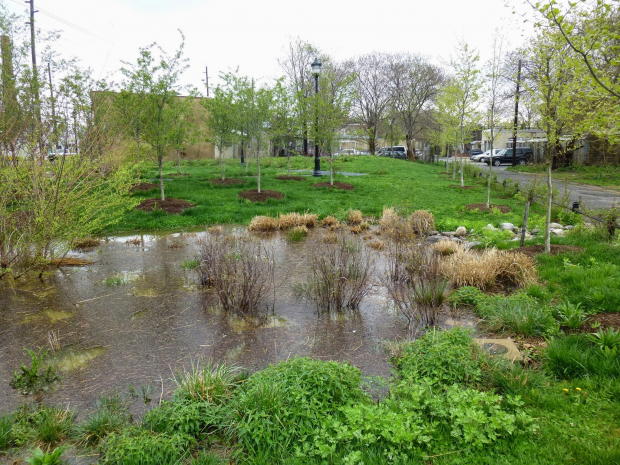
Waterfront South Rain Garden, Camden. Source: Rutgers GIS web map of Camden Green Infrastructure Projects
One municipality that is a good example of what it means to build an expansive green infrastructure system is the City of Camden. Even though Camden’s SCO is using the minimum requirements language set by NJDEP, the city’s actions have gone far beyond that. The city takes part in the Camden SMART initiative founded in 2011 and is made up of several organizations and stakeholder groups including Camden Community Partnership (CCP), the City of Camden (City), Camden County Municipal Utilities Authority (CCMUA), Rutgers Cooperative Extension Water Resources Program (RCE), New Jersey Tree Foundation (NJTF), and the NJ Department of Environmental Protection (NJDEP). Camden SMART is responsible for at least 50 GI projects. The city is filled with tree plantings, rain gardens, stormwater planters and rain barrels. Over 60 million gallons of stormwater have thus far been captured. Between the additional GI projects coming up and the new street bump outs and green curb lines that will be installed as a response to the new SCO requirements, the city aims to eventually capture 30 million gallons annually. Camden is also adept at engaging community members via regular city-wide meetings on upcoming GI projects, sustainability events, community rain gardens, and rain barrel workshops. Two challenges face Camden in the expansion of their GI network: the large amount of impervious surfaces and lack of available space, and litter which has the potential to interrupt the water inundation cycle if too much accumulates in green infrastructure installments. To learn more about how Camden is leading the charge in green infrastructure, visit their interactive map of GI projects.
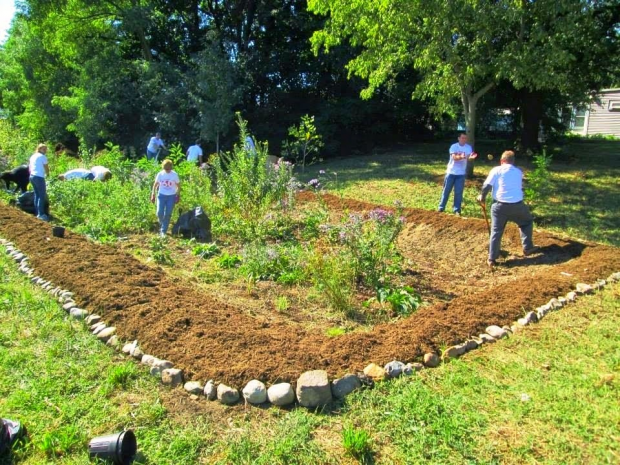
29th Street Biobasins, Camden. Source: Rutgers GIS web map of Camden Green Infrastructure Projects
The changes made by NJDEP to the Stormwater Management Rules bring New Jersey one step closer to achieving climate resilience. Municipalities are working toward incorporating the amendments into their SCOs, but are in need of more support. One strategy to increase dedicated stormwater management funding is to explore the implementation of a stormwater utility. The increased workload and expenses associated with the initiative put additional strain on municipalities. In spite of these challenges, places like Camden demonstrate how powerful green infrastructure can be when local leaders are committed to its installation.
Accessing New Federal Funding for Active Transportation Projects: Camden County Got a Bunch, How Can You?
September 18th, 2023 by Zeke Weston
The Infrastructure Investment and Jobs Act (IIJA) was signed into law by President Joe Biden on November 15, 2021, investing $1.2 trillion in America’s infrastructure. From the IIJA, New Jersey municipal, county, and state governments have the opportunity to tap into once-in-a-generation funding programs, many of which support safe and accessible transportation alternatives for walkers, bikers and rollers. Camden County took advantage of the IIJA opportunity to secure $19 million in federal funding to design and build a new 3.8 mile section of the LINK trail. These new trail segments will connect existing trail segments from the Benjamin Franklin Bridge in Camden to Cooper River Park in Pennsauken.
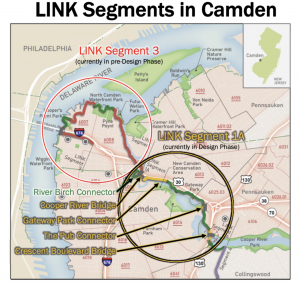
Camden City LINK Trail Map courtesy of the Bicycle Coalition of Greater Philadelphia
The Camden County LINK Trail is a 34-mile multi-use, off-road trail that, when completed, will connect 17 communities in Camden County and serve as the southeast section of the Circuit Trails Network in New Jersey. The LINK is part of a growing network of trail segments that are expected to eventually connect Philadelphia, PA to Cape May, NJ. Funding for the 3.8 mile Camden LINK was awarded from the Rebuilding American Infrastructure with Sustainability and Equity (RAISE), a discretionary grant program from the IIJA. RAISE grants can be used to invest in road, rail, transit or port projects, but Camden took advantage of it to expand their trail network, demonstrating that there are opportunities for active transportation projects to access funding.
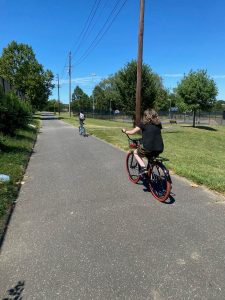
Two kids riding their bikes on an existing LINK Trail segment through East Camden
“Hundreds of people will be able to walk less than ten minutes to new public amenities,” explained Justin Dennis, Camden Program Director with the Trust for Public Land (TPL), on the importance of the Camden LINK. Many Camden residents will be able to walk or bike directly onto the LINK from their neighborhood. From there, the travel and recreation opportunities are vast and include access into downtown and numerous parks throughout the city. The safety of non-motorized users will be prioritized, so that residents can comfortably and safely rely on the trail network. Therefore, the Camden LINK Trail is not simply a recreational amenity, but more importantly an accessible and equitable regional connector. Dennis believes that the “LINK will improve the mental health and social cohesion of the community.” Project boosters hope the LINK Trail will be more than a leisure-oriented mixed-use path, and instead serve as an arterial transportation network for folks to get to and from their destination of choice without the need for or reliance on a car.
Felix Moulier, Project Manager for the Saint Joseph’s Carpenter Society, an East Camden non-profit that focuses on affordable housing and neighborhood development, grew up in Camden and recently moved back to live and work. The more Moulier learns about the LINK trail, the more he understands its value. “The trail’s influence on beautification is an instant win because it has an immediate impact,” he claimed. The creation of trail networks includes trees, flowers, benches and other components that alter the landscape of the community, in turn improving perception of the neighborhood among local residents and visitors. Households and individuals are anticipated to find green neighborhoods more welcoming to rent or buy property, or simply to enjoy local shops, museums, eateries, and other public amenities. Importantly, city residents will no longer have to travel out of their neighborhood to access public green spaces, improving the quality of life for the community. Thus, it serves as an example of how well-developed active transportation networks can positively influence communities in various ways, including providing reliable access to green and open spaces and connecting residents to their local waterway.
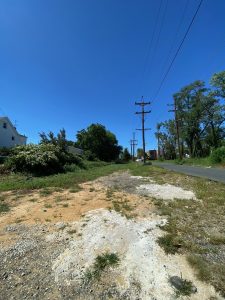

The picture on the left is of an undeveloped trail segment in East Camden, while the picture on the right is of a developed trail segment on the same road.
Francisco Moran, ex-Camden City Council President and Mayor, expressed that multi-use trail networks are “particularly important in a city like Camden, where one-third of the residents don’t own cars.” The new LINK Trail segments will better enable community members who don’t own cars or don’t want to drive, to travel around the city. Residents will not have to rely on cars to get around, rather they can walk or bike to their destination of choice. The lack of bicycle and pedestrian infrastructure in the city has been a major safety concern for folks attempting to get around without a car. The LINK will ensure pedestrians and cyclists have a safe and reliable route to travel through the city.

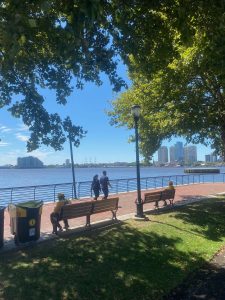
LINK Trail segment along the Delaware River in Camden
IIJA Funding Opportunities
The expanded grant opportunities provided by the IIJA, like the RAISE program that will fund the Camden LINK, will not last forever. IIJA funding is only available through fiscal year 2026 and the application process is extensive. Competitive projects often require feasibility studies, a planning and design process, and various other components that cannot be rushed. Therefore, the time to begin identifying and thinking about potential projects is now. In addition to RAISE, there are multiple IIJA programs that can be accessed for active transportation and complete streets initiatives. The Safe Streets and Roads for All competitive grant program funds Vision Zero initiatives that seek to make access and mobility safer for non-motorized users. The national $5 billion program can be used for active transportation projects that are likely to significantly reduce transportation related deaths and injuries. The Transportation Alternatives Set-Aside (TASA) is a program that has more than doubled in size under the IIJA that can be used for active and multimodal transportation projects, including bicycle and pedestrian facilities and complete streets. The process for applying to the IIJA programs begins long before the respective program deadline. Competitive applications include planning and feasibility studies to demonstrate project viability. This may require applicants to hire a consultant and is just one of numerous application requirements. Therefore, it is important to begin the planning process as soon as possible. Application costs may be covered by government agencies (see below), but even if not, they can unlock large grants. To gain a better understanding of the IIJA program and its potential uses, visit the State of NJ IIJA homepage. For help getting started on applying to the IIJA programs, visit your region’s Metropolitan Planning Organization’s (MPO) IIJA webpage: the Delaware Valley Regional Planning Commission (DVRPC), the North Jersey Transportation Planning Authority (NJTPA), or the South Jersey Transportation Planning Organization (SJTPO). Additionally, folks interested in learning more about how to access the active transportation opportunities in New Jersey can email NJDOT’s Office of Bicycle and Pedestrian Programs (BIKEPED dot
dot nj
nj gov) or the New Jersey Bicycle and Pedestrian Advisory Council (BPAC) (bikeped
gov) or the New Jersey Bicycle and Pedestrian Advisory Council (BPAC) (bikeped ejb
ejb rutgers
rutgers edu) for more information.
edu) for more information.
For help determining who to reach out to and how, feel free to email New Jersey Future’s Land Use Policy Coordinator, Zeke Weston (zweston njfuture
njfuture org) .
org) .
Creating Safe Communities and Options for Walk-Bike-Ride Transportation in New Jersey
August 8th, 2023 by Sneha Patel
“Every decision about transportation is an opportunity to build a clean, healthy, and more prosperous future,” declared Christopher Coes, Assistant Secretary, U.S. Department of Transportation (DOT) as he provided prepared remarks to open the session “Delivering Walk-Bike-Ride Transportation in New Jersey” at the 2023 Planning and Redevelopment Conference co-hosted by the NJ Chapter of the American Planning Association and New Jersey Future.
New Jersey has an exceptional opportunity in the transportation sector to expand walk-bike-ride options in many communities, especially in the face of the large increase in federal funding for transportation, and the unlimited discretion the state has for the use of these funds. The Bipartisan Infrastructure Act allowed DOT to award $1 billion dollars through Safe Streets to create safe corridors, and $4.5 million over the next five years to improve efficiency by providing more affordable public transit. The number of pedestrian fatalities has climbed to the highest levels since 1981, and during 2020-2022 more individuals died in rural, Black, and brown underserved communities, stressing the need for an infrastructure shift to prioritize safety. Crowded streets and large populations in urban neighborhoods can make pedestrians feel unsafe, and the lack of sidewalks along high-speed eight lane stroads in suburban neighborhoods elicit the same feeling. Emphasizing pedestrian safety and encouraging walk, bike, and ride options requires committed local leadership to seek and earn allocated resources and funding for their communities.
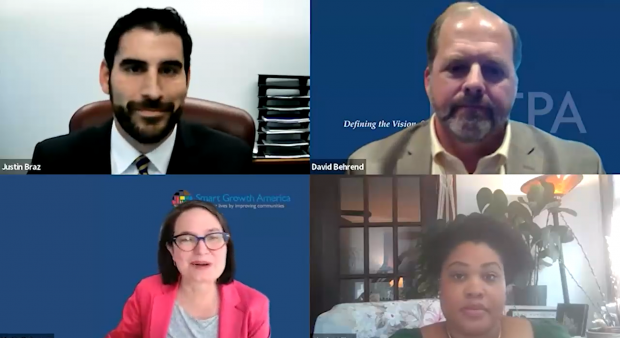
The virtual plenary Delivering Walk-Bike-Ride Transportation in New Jersey at the 2023 NJ Planning and Redevelopment Conference. Top from left to right: Justin Braz, Assistant Commissioner for Transportation Policy and Chief of Staff, New Jersey Department of Transportation; David Behrend, Executive Director, North Jersey Transportation Planning Authority (NJTPA). Bottom from left to right: Beth Osborne, Vice President for Transportation and Thriving Communities, Smart Growth America; Nicole Miller, Principal, MnM Consulting.
The session was moderated by Beth Osborne, Vice President for Transportation and Thriving Communities, Smart Growth America. Panelists offered their insights on the successes and challenges of implementation at the local level. They included: David Behrend, Executive Director, North Jersey Transportation Planning Authority (NJTPA); Justin Braz, Assistant Commissioner for Transportation Policy and Chief of Staff, New Jersey Department of Transportation; Nicole Miller, Principal MnM Consulting; and Christopher Coes Assistant Secretary, U.S. DOT.
Keynote speaker Christopher Coes described the federal government’s strategy for decarbonization and the ambitious goal of net zero carbon emissions nationwide by 2050. Transportation accounts for the major share of U.S greenhouse gas emissions, which is why the DOT, Environmental Protection Agency, and the Department of Housing and Energy have entered the first known memorandum of understanding (MOU) to decarbonize the transportation sector, releasing the U.S. National Blueprint for Transportation Decarbonization to assist states and communities. He stressed the importance of land use in increasing convenience for individuals through improved community design. Schools, job centers, and stores should be in proximity to each other to reduce commute burdens and expand opportunities for alternative transportation.

Keynote speaker Assistant Secretary Christopher Coes with the U.S. Department of Transportation during the virtual plenary at the 2023 NJ Planning and Redevelopment Conference.
Providing technical assistance to communities is necessary to achieve meaningful results. As part of the Thriving Communities cohort, East Orange has been selected as the first participant to receive hands-on technical assistance to connect the communities divided by I-280. Coes recognized that land use needs to be at the forefront of improving transportation infrastructure, adding that DOT provides developing tools and research to explain the connection between carbon emissions and land use to better inform their transportation policies.
“In the next 20 years, the Department of Transportation may be called the Department of Mobility,” Justin Braz mused. He noted increased funding and staff at NJDOT to liaise with communities and provide community members with multiple opportunities to move around. Increasing bikeways and trails and improving sidewalks are crucial to creating livable walkable communities. Braz highlights the seriousness of pedestrian safety and their focus at NJDOT on highway safety. He noted the initial data for 2023 for NJ has been positive; as of June 2023 the fatality rate is down 22% which is an improvement, but conceded “one death is one too many.”
David Behrend described the shift in federal funds from highway to public transit, such as electrifying bus fleets and transit improvements. He explained, “Everyone is rowing in the same direction right now, we want to take advantage of it when we can.” The North Jersey Transportation Planning Authority (NJTPA) aims to create the first-ever regional active transportation plan to improve bike and pedestrian mobility and safety. Behrend pointed out the need for “low-stress facilities,” where pedestrians feel it’s safe and convenient to walk, bike, or ride without the high traffic of cars. One key project Behrend emphasized was developing pathways like the Morris Canal Greenway, a 111-mile historic route cutting across the state from the Delaware River to Hudson County and connecting six counties. Behrend noted, “with Infrastructure Investment and Jobs Act (IIJA) funding, all the existing programs have gotten a degree of additional funding which …allows for more and larger projects.”
“Land use is key, but only comes after an internalized shift,” Nicole Miller declared, speaking on the difficulties of engaging people in slow-moving transportation improvement efforts and the potential rejection of such radical change. A perspective shift can be difficult when the ideal concept of the “American Dream” pressures households into single-family homes with two-car garages. She expressed “car-centric design has eroded urban centers, engrained a reliance on vehicles, promoted less-efficient energy and land-use, and unhealthily tied our economy to fossil fuels.” The cost of transforming the transportation sector cannot be ignored, she admitted, but “that cost must be measured against the lives lost, increased emissions produced, inefficient energy and land use, fewer housing options, and health concerns.”
With the shifting culture and more complex challenges of today, programs that weren’t created for the present ideology have to evolve. Braz described reshifting priorities to focus on long-term plans and the importance of committing to a full Complete Green Streets policy, with priority granted to projects that can be completed in two to three years.
Regional and local leaders should have a detailed plan that identifies specific needs to take advantage of existing funds. Behrend highlighted the NJTPA’s local demonstration project library for communities to access materials to test a temporary project setup and survey their impact. Braz reminded viewers not to overlook the value in targeting areas that only require minute fixes to address concerns like broken streetlights or weathered roads, in turn building community support behind quick improvements.
Shifting the attention towards public transportation can be done by involving community members, increasing public transportation options, and adding cost-friendly electric vehicles for younger people. Spreading awareness that increasing highway width does not decrease congestion, rather it only induces further demand and begets greater congestion. Cars have to be the most burdensome option, and walk-bike-ride should be better, cheaper, and faster Nicole Miller asserted. She continued that taking the train to work and entertainment centers “are sacrifices that people have to make, and part of the problem is we need a revised vision to make radical change.”
Rethinking Colonial Narratives and Transforming Native Insight into Actions: Indigenous Preservation of History
July 20th, 2023 by Sneha Patel
“Lenape means ‘the original human’, and that is where we need to get back to,” Chief Vincent Mann expressed, adding, “[reconnecting with the land] would provide us a way to encourage the people of tomorrow to take what we are sacrificing to create for them to further the future.” Indigenous people have a rich history of interacting in harmony with the environment. Colonialism commodified nature and continues to overshadow the indigenous history that existed in the Hudson Bay, and severed modern society from the ways of life that sustained pre-colonial populations. Panelists at a session dedicated to the subject at the 2023 Planning and Redevelopment Conference suggested creating a cultural interpretation center that preserves native history, through immersive teaching and community formation, as the start of a new strategy in facing a changing climate, while providing historical context on the Hudson Bay estuary and its ecosystem.
Moderated by Nagisa Manabe, Director of Development, Ramapough Culture and Land Foundation. The 2023 Planning and Redevelopment Conference session “Challenge Established Colonial Narratives of this Region’s History and Transform How We Communicate and Preserve indigenous History” recollected the painful past of native people that lived in the Hudson Bay area, and the importance of rewriting colonial history to disclose indigenous truths. The speakers Kerry Hardy, Historian, Lead Researcher and Cartographer at the Public History Project; Jack Tchen, Professor and Director, Clement Price Institute of Rutgers University Newark; Vincent Mann, Chief, The Turtle Clan of the Ramapough Lenape Nation; discussed the important role New Jersey indigenous communities can play in our region’s development and ensuring a resilient and equitable New Jersey.

Kerry Hardy, Historian, Lead Researcher and Cartographer at the Public History Project, speaking about the Hudson Bay and oyster bank during the virtual session, Challenge Established Colonial Narratives of this Region’s History and Transform How We Communicate and Preserve indigenous History, at the 2023 NJ Planning and Redevelopment Conference.
The Hudson Bay area was a natural source for oyster, clam, fish, and waterfowl resources that provided enough protein to sustain humans through the winter season. Native groups, such as the Munsee/Mohican, Hackensack, Raritank, Assunpink, Lechauwitank, and Minisink, navigated the Minisink Path 100 miles or more to the mouth of the Hudson River. Cheesequake, at the mouth of the Hudson, became a mecca and gathering site for native populations, where ceremonial council fires were held. Today, massive shell deposits hint at Cheesequake being once a major social center in indigenous life.
New Jersey’s estuary and tributary rivers, such as the Passaic and Hackensack River, previously held a seven mile wide oyster bank. Colonization spurred the conversion of wampum shells into currency for fur trade. Jack Tchen reflected “During this brief period of time we go from millennial uses of the bioregion as a cultural, food, and lifeways commons, to settler colonialism by turning natural resources of the region into a commodity marketplace.” Genocide and industrialization have left the original oyster bank largely devoid of natural resources and buried under a defunct railyard. Today, approximately half of the original oyster bank is covered by Liberty State Park.

Vincent Mann, Chief, The Turtle Clan of the Ramapough Lenape Nation, speaking during the 2023 NJ Planning and Redevelopment Conference with image of Liberty Park spanning approximately half of the original oyster bank.
Chief Mann remarked on the way that land and people hold the suffering of the violence that took place. The land that once forced migration of indigenous people became the entry point for millions of immigrants into the United States of America. “When you look at the Liberty State Park, it is not just the destruction you see, but the ability to replant the seed. To have that seed be something that can prosper and benefit all of humanity by telling the story of this land prior to contact, and telling the story of enslavement,” Chief Mann reflected.
Chief Mann proposes a cultural interpretive center to recount the history of America before it became the United States, suggesting the center would expose visitors to the parts of history that have been erased, and pave the way for an unprecedented reconnection to nature. Tchen explained the intimate knowledge of native people can demonstrate ways to work in harmony with nature to “rewild and protect the region, so that we have hope for the future and not have to build high walls to keep the ocean away or drain the rainstorms that are hitting us.”
Indigenous people, principally members of Lenni-Lenape tribes, are reasserting their ties to the environment, and reclaiming the shoreline to reseed oyster beds for future generations. “What you call climate change, I call human change,” Chief Mann expressed. He imagines the Liberty State Park interpretive center as a multicultural hub to preserve and spread knowledge about the proper way to treat nature, providing a travel destination for people to deeply interact with nature. He commented “we could create trail centers…, wild medicinal gardens, and ceremonial stone landscapes to educate people.” Knowledge would become a form of protection to keep hiking trails, like the Appalachian, untouched and clean.
“Colonialism isn’t just the domination of the Dutch or the British over the people…but it’s also about colonizing nature itself,” Tchen remarked. “This vision is also about how the park is a portal in which another way of life is revived.” Interpretive centers are crucial in showing what culture is still alive and showing the knowledge that the indigenous people have that has been recognized by scientists. While the world operates in colonial thought, Chief Mann believes that if they can collaborate with scientists on alternate opportunities that native people follow, they can inspire future generations to view nature differently. He explained, “we are planting the human seed of thought and all of those things need to be nurtured.” Chief Mann concluded the session with inspiring comments for the future. “The sun is always shining somewhere…There is always hope for tomorrow, and our hope is to see that in tomorrow’s people.”
With Recession in the Forecast, How Prepared is NJ’s Economy for Upcoming Rain?
July 20th, 2023 by Michael Atkins

Jeffrey Otteau, Managing Partner & Chief Economist, Otteau Group Inc.
As the world slowly but surely emerges from the challenges of the COVID-19 pandemic, all of us are evaluating the new parameters of our state and national economies that have experienced stimulus spending, historic inflation, supply chain disruptions, and high interest rates all in quick succession. Despite this emergence, the complete upheaval of labor, housing, and consumer markets has not meant all the pieces have returned to where they once were pre-2020.
Economist Jeff Otteau provided an in-depth analysis of NJ’s economic outlook in the months and years ahead, as well as an examination of these structural forces and their implications for real estate demand patterns in his keynote session, “Inflation, Interest Rates, and Indicators of NJ’s Post-Pandemic Economy”, at this year’s Planning and Redevelopment Conference, co-hosted by New Jersey Future and the American Planning Association NJ Chapter.
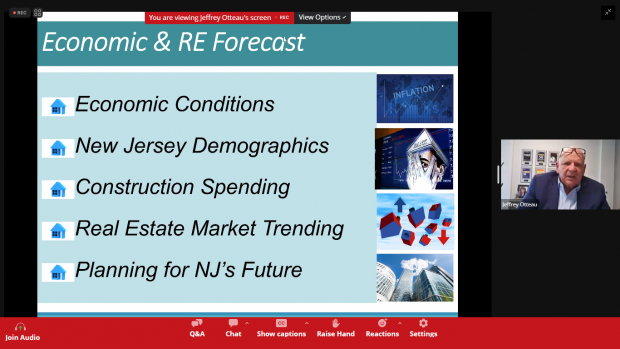
Jeffrey Otteau, Managing Partner & Chief Economist, Otteau Group Inc., speaking during his keynote session, Inflation, Interest Rates, and Indicators of NJ’s Post-Pandemic Economy, at the 2023 NJ Planning and Redevelopment Conference.
What’s Happening in the Economy?
The aftereffects of the pandemic were broadly favorable to New Jersey’s demographic and economic profile, as migration from New York City resulted in increased demand for real estate and steady job creation has returned employment to pre-pandemic levels. More recently however, the combined effects of elevated inflation and interest rates have set the stage for a reset in 2023 as the Federal Reserve Bank attempts to navigate a soft landing for the economy. “Real estate markets [will] enter a correction phase, with the [Federal Reserve] doing its level best to get that to happen. Expectation is that sometime in the near term the Fed will go through a correction phase in the NJ economy,” Otteau explained.
Otteau linked the speedy recovery of jobs to wage growth and price inflation. “We have not only recovered all the jobs we lost [due to pandemic downsizing], both locally and nationally, than we had pre-pandemic…We are up 4 million jobs nationally and 100,000 jobs here in NJ. With so many people working and collecting wages, it creates more income for spending, which feeds into inflation.” Other contributing factors to inflation include government stimulus, however much of that has been spent and accounted for, with today’s inflation most likely caused by the tailwinds of the aforementioned increase in employment. The Federal Reserve has made it abundantly clear their target for inflation is less than 2%, a goal we have not yet reached. As Otteau notes, “Inflation peaked last summer at 9% and has trailed back down to a 4% level. This has happened principally by the Federal Reserve increasing interest rates, which has slowed spending due to increased borrowing rates.” A cycle of rising interest rates is expected to lead to the contraction of the economy (nationally) by 1-2 million jobs, triggered by firms earning less profit on their enterprises due to increased borrowing costs, and ultimately a decline in consumer spending, which will aid in cutting inflation.
Another indicator Otteau examined in his plenary was the rate of construction inflation costs in NJ— both North and South Jersey experienced peaks of 17% and 20% cost increase respectively, with both brought down to approximately 3%, due to increased interest rates. (It should be noted this only means the increase in costs has slowed down, and construction costs overall have not reduced.) Rising costs of construction indicate increased costs to developers to build housing in NJ and maintain profitability, as real wages (essentially capacity for renters or buyers to meet increased rental or purchase costs) has lagged behind inflation. Home prices have remained elevated, and continue to rise, while commercial real estate is still recovering from a 40% decline in transaction volume.
While inflation has driven up costs on borrowing and developing housing, inflation has dramatically hurt American consumers. The cost of goods and services that wages are spent on, has continually outpaced real wage increases. Paychecks, which exceeded inflation in early 2021, have not kept pace with inflation throughout all of 2022, with the gap only now beginning to close. “American consumers have responded by putting these costs on their credit cards. We now have the highest amount of credit card debt in our history, and we’re also seeing a rise in delinquency rates among credit card consumers.” This is likely to lead to credit issues and defaults in an anticipated economic downturn.
“We are likely headed for a recession later this year. Banks have taken extraordinary measures to tighten their lending stances,’ Otteau explained in preparing for rainy days ahead. The mismatch between inflation and salary increases and the pivot to credit cards to cover that gap has led to a dramatic reduction in saving rates and totals among American consumers who are running out of savings, another event that typically predicts an economic downturn or recession.
This has not translated into increased delinquency rates among NJ mortgages, with only about 1 out of every 100 homes in NJ missing three or more mortgage payments. These rates are lower than the incredibly low delinquency rate at the start of 2020 (pre-pandemic) and are wildly lower than peak delinquency rates (approximately 12%) in the wake of the 2008 Great Recession. Otteau indicates that these low observed delinquency rates can forecast a “shallow” and “short” reset in the anticipated recession.
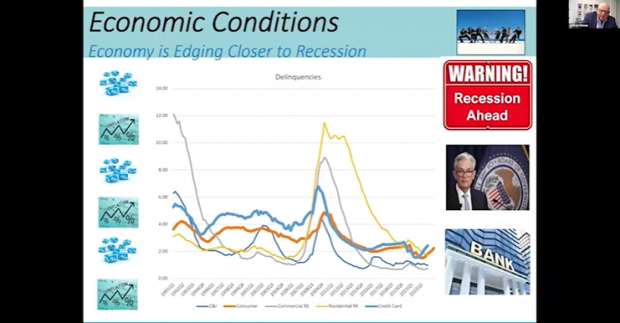
Jeffrey Otteau, Managing Partner & Chief Economist, Otteau Group Inc., speaking during the 2023 NJ Planning and Redevelopment Conference about predicted economic conditions.
NJ Demographics
While demographic data can lag up to 2 years behind other observed trends, they still provide information in analyzing our state economy and outlook. NJ remains an outbound migration state, with 2 out of 3 people leaving NJ for a reason other than retirement, according to a United Van Lines survey of their customers. “Half of everyone who is leaving can afford to stay here in NJ…with an income in excess of $150,000. This is something we need to give attention to and think about what can be done to reduce this outflow. Nothing good comes from residents leaving by choice who are high income earners in a state,” Otteau cautioned. NJ’s current net migration rate of -49,000 people is less than the pre-pandemic peaks in the -70,000 net migration rates. “We had 91,000 people move from NY to NJ. These people were putting distance between themselves and highly densely populated areas to reduce their risk of exposure to vectors of covid transmission, rising crime rates in NYC, and taking advantage of employer policies permitting remote work.” It will be important for economists, policymakers, and researchers to keep a close eye on demographics and population data in the coming years as we continue to track the effects of the pandemic and discern temporary from permanent impacts to real estate and labor markets, and our state and national economies.
Additional alarming indicators of NJ’s economic outlook include a demographic cliff of the composition and size of households. NJ continues to hemorrhage young adults and is seeing a decline in population “under 20”. These two population segments are incredibly crucial to future economic predictions; the 24-40 year cohort represent today’s most in-demand members of the workforce, the drivers of consumer spending, and the people who will purchase and form households, engaging in the 20+ year spending habits associated with forming a family. NJ is also seeing a reduction in population under 20 years of age, which will translate into contraction of this crucial block of spenders in the 2040s.
Housing Costs and Construction Spending
The number of home sales in the Garden State has declined for 24 consecutive months, which has reversed the pandemic bump that made NJ an attractive destination to NYC households moving from the city. “Post Service reported that 500,000 NYC households filed a change of address form, with NJ being a very large beneficiary.” Home sales have declined about 40% over the past two years, in a correction phase following the pandemic. One factor is the low inventory of houses on the market — currently NJ has approximately half the available houses on the market versus pre-pandemic levels, in part due to current homeowners not wanting to relinquish favorable interest rates, keeping “trade up” buyers on the sidelines. The rental market is also showing indicators of tough economic conditions for renters. With the median apartment rental cost in NJ clocking in around $2100 / month, senior rental housing is more costly than the median, indicating a very hot market for senior rentals throughout the state. Commercial spaces also forecast a bleak picture as approximately 3 million square feet of commercial spaces in NJ have gone dark in the past year.
2022 was a bounce back year for construction spending from the decline of the pandemic, with increases in Single Family and Multi-Family Household constructions, which have rocketed to over 200% increase with over $500 million dollars spent in the first quarter of 2023 on multi-family housing. Commercial and industrial construction have contracted slightly, largely attributable to the increased costs of goods and services due to inflation. The elevated pressures of inflation is likely to cool the spike in construction spending in the residential sectors.
Outlook Ahead
“Technology cuts both ways. While technology can be exciting, it is also a big threat.” Otteau cited an Oxford Study that predicts 47% of all US jobs to be lost to artificial intelligence. Data Centers are expected to quickly come into high demand to process all of the data as technology advances and integrates even further into our economic activities, similarly the telehealth economy is expected to continue to grow, as healthcare can be provided to patients remotely. This automation push, in tandem with increased interest rates, predicts a rise in unemployment in NJ and nationality in 2023.
Otteau concluded with cautious optimism, and pointed toward public policy solutions needed to respond to broader national economic pressures. “We live in one of the most prosperous places in the country, and therefore one of the most prosperous places on the planet. We have a highly educated population and a high quality of life. We are facing economic pressures and stressors in the next 12 months, which should be short and shallow in their recession effects, with a rebound expected sometime in the next year. We have a lot of work to create a place for people and employers to locate to ensure our future prosperity.”
Promoting Integration at the Local Level
July 20th, 2023 by Tim Evans
While New Jersey is one of the most diverse states in the nation at the macro level, at the local level it is also one of the most segregated. The state has grown more demographically diverse over the last two decades, but most of its individual towns and neighborhoods are either predominantly white or predominantly non-white, with few places occupying the “diverse” range in between. What can leaders do to promote more stable integration, so that towns can remain in the “diverse” space for the long term, rather than just momentarily passing through as part of a transition from one extreme to another?
Panelists in the session on “Promoting Integration at the Local Level” at the 2023 Planning and Redevelopment Conference offered insights to promoting diversity at the municipal level. Jessica Rafeh, Committeewoman and former Mayor of Pennsauken Township; Michele Alonso, Director of Planning and Redevelopment for the City of Asbury Park; and the session’s moderator, Nancy Gagnier, the Executive Director of the South Orange/Maplewood Community Coalition on Race talked about their experiences at the local level, while Jeffrey Perlman, Senior Director of Planning at the North Jersey Transportation Planning Authority (NJTPA), provided a regional perspective.
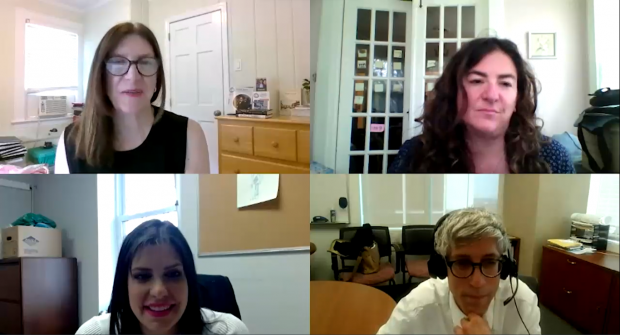
The virtual session Promoting Integration at the Local Level at the 2023 NJ Planning and Redevelopment Conference. Top row from left to right: Nancy Gagnier, Executive Director, South Orange/Maplewood Community Coalition on Race; Michele Alonso, Director of Planning and Redevelopment, City of Asbury Park. Bottom row from left to right: Jessica Rafeh, Committeewoman and former Mayor, Pennsauken Township; Jeffrey Perlman, Senior Director of Planning, North Jersey Transportation Planning Authority (NJTPA).
At the local level, a big part of promoting economic diversity means making sure there are housing options for households of all income levels, which requires local zoning that permits a diversity of housing types. Rafeh specifically mentioned Pennsauken’s broad range of housing types, and that the township is one of the rare suburban towns that already exceeds its Mount Laurel obligation for lower-income units. Alonso talked about the benefits of inclusionary zoning ordinances, noting that Asbury Park’s ordinances require new developments to be 20% affordable to be eligible for density bonuses. She also pointed out that redevelopment plans negotiated with developers offer an opportunity for towns to encourage a range of housing options: “Redevelopment agreements are an important tool that towns can use to make sure new developments are as economically inclusive as possible.”
Gagnier described South Orange/Maplewood’s first-time homebuyers loan program that is targeted at racial minorities to help them move into town, or to help existing renters graduate to homeownership. “Towns need to pay attention to changing demographics if they want to foster or preserve integration, so they can take steps to stay ahead of the changes,” she said. Achieving stable integration means towns must stay engaged as development patterns and housing markets change.
As a counterpart to programs and policies designed to help new residents move in, local leaders can also take steps to allow existing residents to stay in town when revitalization puts upward pressure on home prices, so that towns don’t become “victims of their own success” (a term cited by both Gagnier and Alonso as being a concern in their towns). Alonso said that Asbury Park recently adopted rent control as a way to guard against displacement of long-time residents, allowing them to participate in the benefits of revitalization when it happens. For homeowners, both Rafeh and Gagnier talked about local programs to help people finance home repairs.
Gagnier observed that while the percent of New Jersey’s population living in mixed-race neighborhoods has gone up in recent decades, “we still in many ways experience our lives in what feel like separate, segregated existences.” Maintaining good public spaces is one technique local officials can undertake to ensure mixed-race and mixed-income neighborhoods actually result in a feeling of diversity and belonging, with programmed public events that encourage people of different backgrounds to interact. Rafeh said she was excited about the construction of a new community center in Pennsauken intended to host such events. Over the longer term, Rafeh also mentioned the importance of representation on governing bodies in making people from diverse backgrounds feel included.
Perlman offered perspective about higher levels of government, saying that the NJTPA pays attention to changing demographics because they may mean changing demand for transportation services, and the organization needs to adapt. NJTPA’s Plan 2050 cites regional equity as one of the organization’s planning objectives, and NJTPA also must determine how to advance the federal Justice40 initiative, which requires that transportation funding must prioritize disadvantaged communities that have suffered in the past from a lack of transportation investments, or that have borne the brunt of the negative effects of past transportation projects. NJTPA will thus be seeking to take active steps to promote stable racial and economic integration, like aligning transportation investments with the state’s affordable housing policies and integrating housing needs into its long-range planning.
At the state level, Gagnier suggested that the school funding formula could provide more funding to diverse districts as a way of promoting integration. Rafeh said other state funds could provide more local assistance to towns that are trying to promote stable integration, via programs like home loan assistance or small business startup loans, since new businesses are often started by residents from demographic groups that are new to town.
For more about what local leaders can do to promote integration, see Promoting and Maintaining Racial Integration: Lessons from Selected New Jersey Towns, by New Jersey Future intern Isabel Yip, which served as the inspiration for this session and for which several of the panelists were also interviewed.
